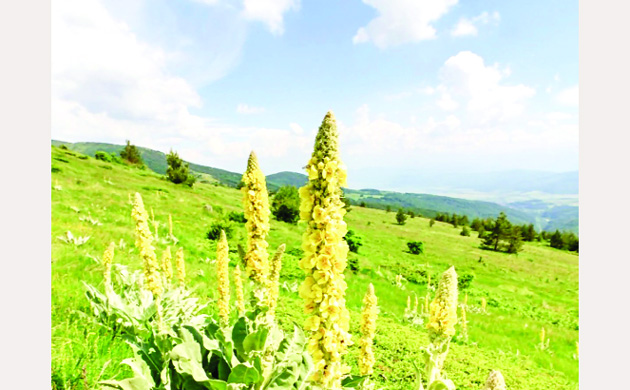Dr Vikas Sharma, Abeeda Mushtaq
Mullein is known to help / treat coughs, chest congestion and some people smoke mullein to help / kick the tobacco habit and to aid in the quitting of marijuana.
Verbascum thapsus, belonging to family Scrophulariaceae, is commonly known as great or common mullein, velvet dock, velvet plant, woolly mullin, witch’s candle or ban tambaku (hindi). Mullein, a biennial, perennial or rarely an annual, with a deep tap root, is found all over Europe, Temperate Asia, North America and In Medieval Europe, mullein saw widespread use, even earning names like “candlewick plant” for its wooly, flammable leaves. It is often found in disturbed areas including roadsides, old fields, pastures, railroad right-of-ways, vacant lots and waste places. It is a common weedy plant that spreads by prolifically producing seeds, but rarely becomes aggressively invasive, since its seed require open ground to germinate.
The dried leaves are sometimes smoked in an ordinary tobacco pipe to relieve the irritation of the respiratory mucus membrane and completely control the cough on consumption. The flowers placed in a bottle and set in the sunshine are said to yield a fatty matter, valuable as a cure for haemorrhoids. The leaves, roots and flowers are also anodyne, antiseptic, antispasmodic, astringent, emollient, nervine, vulnerary, analgesic, antihistaminic, anticancer, antioxidant, antiviral, bacteristat, cardiodepressant, oestrogenic, fungicide, hypnotic and sedative.
Mullein has been used as a remedy for the respiratory tract, particularly in cases of irritating coughs with bronchial congestion. Mullein leaves and flowers have expectorant and demulcent properties which are used by herbalists to treat respiratory problems such as bronchitis, dry coughs, whooping cough, tuberculosis and hoarseness. The flowers are mildly diuretic and have a soothing and anti-inflammatory effect on the urinary tract. The leaves are also diuretic, helping to reduce inflammation of the urinary system and to counter the irritating effect of acid urine.
In Europe, a sweetened infusion of the flowers strained in order to separate the rough hairs, is used as a domestic remedy for mild catarrhs and colic. A conserve of the flowers has also been employed against ringworm and distilled water of the flowers, was long reputed to be a cure for burns and erysipelas. A decoction of roots febrifuge, is used to alleviate toothache and also to relieve cramps, convulsions and migraines. The juice of the plant and powder made from the dried roots is said to quickly remove rough warts, when rubbed on them.
Mullein leaves contain several therapeutic compounds that benefit the respiratory tract through various mechanisms. Mucilaginous polysaccharides coat and soothe mucous membranes. Flavonoids and saponins act as expectorants to loosen mucus secretion and stimulate coughing up of phlegm. The stems are used as torches, tinder and wicks for candles. The poultice of the leaves is a good healer of wounds and is also applied to ulcers and tumors. A poultice made from the seeds and leaves is used to draw out splinters. Tea made from the flowers reportedly has a soothing, sedative effect. The leaves contain rotenone (insecticide) and coumarin (prevents blood clotting).
Mullein oil is recommended for earache and discharge from the ear and for any eczema of the external ear and its canal. Mullein oil is a valuable destroyer of disease germs. The oil being used to treat gum and mouth ulcers is very effective. The seeds of mullein are said to be toxic and should not be used in any of these preparations. The seeds when thrown into the water are said to intoxicate fish and are used by poachers for that purpose, being slightly narcotic. Major toxic elements affecting the circulatory, respiratory and central nervous systems of the fish include saponin, rotenone and glycoside. The common mullein causes fish to have difficulty in breathing.
(The authors are from the Division of Biochemistry, SKUAST-Jammu)
Trending Now
E-Paper


